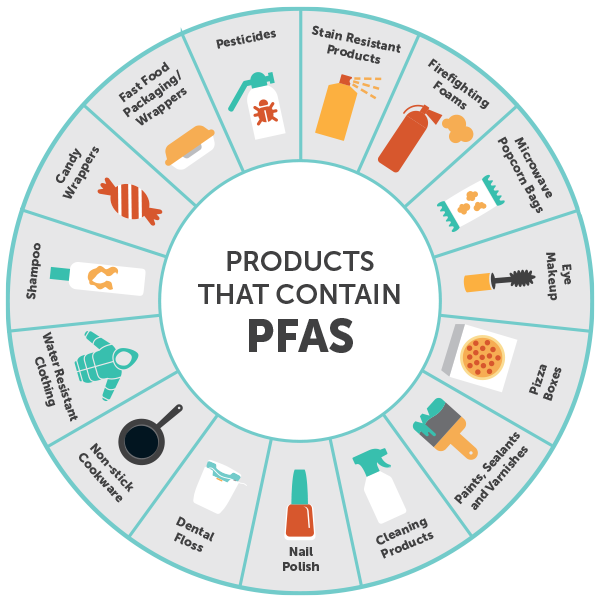PFAS Facts
PWC’s top priority is providing high-quality drinking water that meets or exceeds all current regulatory standards. PWC is also committed to continued advocacy to prevent PFAS (Per- and polyfluoroalkyl substances) from being discharged into our source water so that we can eliminate the exposure and financial burden for our customers.
New EPA Standards Announced
The EPA regulates the safe levels for hundreds of compounds in drinking water. PWC meets or exceeds all current EPA regulations for drinking water. Prior to the EPA announcing proposed PFAS drinking water standards in 2023, there had been no established regulatory limits for PFAS in drinking water. However, for nearly 10 years, PWC has advocated with regulatory agencies to reduce and prevent the discharge of industrial pollution/PFAS into the Cape Fear River, our primary drinking water source.
The EPA announced its final PFAS drinking water standards at PWC’s P.O. Hoffer Water Treatment Facility on April 10, 2024. Previously, the guidance was a Health Advisory Limit of 70 parts per trillion (ppt). The final limit is 4 ppt. Water facilities like PWC’s P.O. Hoffer and Glenville Lake Water Treatment Facilities will be required to meet this new standard within 5 years.
What are the levels in PWC’s drinking water?
PWC monitors our source waters and the treated drinking water leaving our two treatment plants. PWC does quarterly monitoring for PFAS.
PWC’s PFAS monitoring levels have been well below the previous PFAS health advisory level of 70 ppt (parts per trillion). For perspective, 1 part per trillion is equal to 1 drop of water in 10 million gallons of water (or 20 Olympic size swimming pools), one minute in two million years or one penny in $10 billion.
Where does PFAS come from?
While PFAS are present in our source water, the EPA says 70% of a consumer’s exposure to emerging contaminants comes from non-drinking water sources.
In Fayetteville, it has been well reported a predominant source of emerging contaminants is the use of and manufacturing of products upstream of Fayetteville including cosmetics, shampoos, paints, food packaging, cleaning, stain and stick resistance products.
Drinking water can be an additional source of exposure in communities where these chemicals have entered the water supplies. Most uses of PFOA and PFOS were voluntarily phased out by U.S. manufacturers in the mid-2000s however, there are a limited number of ongoing uses, and these chemicals remain in the environment due to their persistence and the inability to degrade.
What is PWC doing about PFAS?
PWC has had ongoing education, provided customers testing results, and updates to our efforts to respond to the PFAS threat. This information is reported in our customer communications, our annual water quality report, on our website, and local media reports.
Like many other water utilities, PWC has been conducting research and testing for PFAS long before the EPA made their final announcement about maximum contaminant levels in April 2024.
PWC’s testing is analyzed by an EPA-certified Laboratory and is compliant with all current EPA testing methods. Our levels are far closer to the EPA limits. You may have seen media reports of PFAS levels in our source water being tested with a home testing kit, but that testing and results are not consistent with EPA reporting.
We are always available to talk about how we produce and deliver your drinking water and the steps we take to maintain water quality. Please contact us at 910-483-1382 or h2o@faypwc.com if you have questions.
Planned Water Treatment Upgrade
We understand the public’s desire for swift action to remove PFAS. It is important to know that a water treatment upgrade is a major infrastructure investment and is not an off-the shelf solution. The upgrade must be designed specifically for each of our drinking water plants.
Granular Activated Carbon (GAC)
The planned water treatment upgrade required studies to determine the most effective method for PWC. We conducted this study between October 2021-October 2022 and determined the Granular Activated Carbon (GAC) media/method to be the most effective in removing PFAS.
As this GAC upgrade is being designed and built, we have also been actively working to upgrade our current Powder Activated Carbon (PAC) treatment capabilities to allow a higher dosage than is currently possible. While PAC is not as efficient or economical as GAC, it can effectively remove modest amounts of PFAS and it will assist us in addressing PFAS until GAC can be installed.
PAC construction begins this spring and is expected to be completed by April 2026. Our GAC upgrade is expected to be operational by February 2028.
Funding the Upgrade
Upgrading our plants to remove industrial pollutants will be a significant cost to our customers, with a projected cost of around $80 million.
PWC staff has sought out funding to reduce the financial burden on our customers. We have received more than $30.5 million in funding for our GAC upgrades. This includes $11.5 million in grants from federal infrastructure and state drinking water revolving funds. $19 million is a low interest loan from state drinking water revolving funds.
In addition, we continue to seek other funding. We are currently working with the North Carolina Department of Environmental Quality representatives to request an additional $18 million that includes a potential $9.7 million toward our PAC facility upgrades. We will also actively continue pursuing federal and state funds for the remaining $49.5 million needed for the GAC upgrade. PWC anticipates an annual cost of $10-12 million per year to operate and maintain the GAC.
PWC is Committed to Providing Safe Drinking Water
PWC was the first utility in North Carolina to be recognized with the Partnership for Safe Drinking Water’s Director’s Award for outstanding commitment to quality drinking water treatment. Every year since receiving the award in 2000, PWC has continued to maintain the award’s high standards. PWC draws water from two independent water sources, the Cape Fear River and Glenville Lake. PFAS are in our source water as a results of the use of and manufacturing of products upstream of Fayetteville. It cannot be removed through our traditional water treatment process.
Because of this, over the last decade, we have partnered with other communities and the North Carolina Department of Environmental Quality (NCDEQ) to advocate having this compound and other unregulated contaminants regulated and ultimately removed from the Cape Fear River. Most recently, in 2021, PWC actions lead the state to impose lower limits on the City of Greensboro’s discharges of 1,4-dioxane from the T.Z. Osborne wastewater treatment plant, sharper penalties for non-compliance, and increased sampling/pollution control requirements to improve the water quality in the Cape Fear River Basin.



